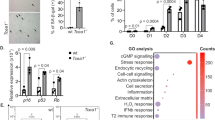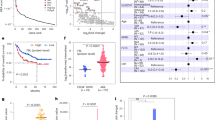Abstract
The HPV16 E7 oncoprotein neutralizes several cell cycle checkpoints, favouring the entry of quiescent cells into S phase. This activity is mediated in part by association of E7 with the pocket proteins and consequent activation of E2F transcription factors. In addition, HPV16 E7 protein is able to promote apoptosis. In this study we demonstrate that the ability to induce apoptosis is a common property of E7s belonging to both benign and malignant HPV types. The E7-induced apoptosis is mediated by inactivation of pRb, whilst neutralization of the other two pRB-related proteins, p107 and 130, is not sufficient to trigger apoptosis. Moreover, we show that certain point mutations in the conserved region 1 (CR1) of HPV16 E7 abolish the induction of apoptosis without altering the ability to stimulate S phase. Thus, these two E7-mediated cellular events, apoptosis and S phase entry, can be separated in immortalized rodent fibroblasts. Our findings demonstrate that the E7-mediated pRb destabilization is not required for its ability to drive quiescent cells into S phase and to induce apoptosis. Finally, expression of E7 proteins in NIH3T3, which lack a functional p19ARF, does not lead to p53 accumulation, indicating that the E7 impacts upon additional cellular pathways to promote apoptosis.
This is a preview of subscription content, access via your institution
Access options
Subscribe to this journal
Receive 50 print issues and online access
$259.00 per year
only $5.18 per issue
Buy this article
- Purchase on Springer Link
- Instant access to full article PDF
Prices may be subject to local taxes which are calculated during checkout







Similar content being viewed by others
References
Armstrong DJ and Roman A . 1993 Biochem Biophys Res Commun 192: 1380–1387
Banks L, Barnett SC and Crook T . 1990a Oncogene 5: 833–837
Banks L, Edmonds C and Vousden K . 1990b Oncogene 5: 1383–1389
Barak Y, Juven T, Haffner R and Oren M . 1993 EMBO J 12: 461–468
Barbosa MS, Edmonds C, Fisher C, Schiller JT, Lowry DR and Vousden KH . 1990 EMBO J 9: 153–160
Bates S, Phillips AC, Clark PA, Stott F, Peters G, Ludwig RL and Vousden KH . 1998 Nature 395: 124–125
Boyer SN, Wazer DE and Band V . 1996 Cancer Res 56: 4620–4624
Ciccolini F, Di Pasquale G, Carlotti F, Crawford L and Tommasino M . 1994 Oncogene 9: 2342–2348
Davies R, Hicks R, Crook T, Morris J and Vousden K . 1993 J Virol 67: 2521–2528
de Stanchina E, McCurrach ME, Zindy F, Shieh SY, Ferbeyre G, Samuelson AV, Prives C, Roussel MF, Sherr CJ and Lowe SW . 1998 Genes Dev 12: 2434–2442
Debbas M and White E . 1993 Genes Dev 7: 546–554
Demers GW, Foster SA, Halbert CL and Galloway DA . 1994 Proc Nat Acad Sci USA 91: 4382–4386
Dyson N, Howley PM, Munger K and Harlow E . 1989 Science 243: 934–937
Evan GI, Wyllie AH, Gilbert CS, Littlewood TD, Land H, Brooks M, Waters CM, Penn LZ and Hancock DC . 1992 Cell 69: 119–128
Flint J and Shenk T . 1997 Annu Rev Genet 31: 177–212
Haupt Y, Maya R, Kazaz A and Oren M . 1997 Nature 387: 296–299
Hickman ES, Picksley SM and Vousden KH . 1994 Oncogene 9: 2177–2181
Honda R, Tanaka H and Yasuda H . 1997 FEBS Lett 420: 25–27
Hsieh JK, Fredersdorf S, Kouzarides T, Martin K and Lu X . 1997 Genes Dev 11: 1840–1852
Hu TH, Ferril SC, Snider AM and Barbosa MS . 1995 Intern J Oncol 6: 167–174
Iglesias M, Yen K, Gaiotti D, Hildesheim A, Stoler MH and Woodworth CD . 1998 Oncogene 17: 1195–1205
Jones DL and Munger K . 1997 J Virol 71: 2905–2912
Jones DL, Thompson DA and Munger K . 1997 Virology 239: 97–107
Kamijo T, Weber JD, Zambetti G, Zindy F, Roussel MF and Sherr CJ . 1998 Proc Natl Acad Sci USA 95: 8292–8297
Kouzarides T . 1995 Semin Cancer Biol 6: 91–98
Kubbutat MH, Jones SN and Vousden KH . 1997 Nature 387: 299–303
Lam EWF, Morris JDH, Davies R, Crook T, Watson RJ and Vousden KH . 1994 EMBO J 13: 871–878
Lowe SW and Ruley HE . 1993 Genes Dev 7: 535–545
Mansur CP and Androphy EJ . 1993 Biochim Biophys Acta 1155: 323–345
McCaffrey J, Yamasaki L, Dyson NJ, Harlow E and Griep AE . 1999 Mol Cell Biol 19: 6458–6468
Momand J, Zambetti GP, Olson DC, George D and Levine AJ . 1992 Cell 69: 1237–1245
Morgenstern JP and Land H . 1990 Nucleic Acids Res 18: 3587–3596
Nevins JR . 1998 Cell Growth Differ 9: 585–593
Oliner JD, Pietenpol JA, Thiagalingam S, Gyuris J, Kinzler KW and Vogelstein B . 1993 Nature 362: 857–860
Pan H and Griep AE . 1994 Genes Dev 8: 1285–1299
Pan HC and Griep AE . 1995 Genes Dev 9: 2157–2169
Pear WS, Nolan GP, Scott ML and Baltimore D . 1993 Proc Natl Acad Sci USA 90: 8392–8396
Phelps WC, Münger K, Yee CL, Barnes JA and Howley PM . 1992 J Virol 66: 2418–2427
Phelps WC, Yee CL, Münger K and Howley PM . 1988 Cell 53: 539–547
Pomerantz J, Schreiber-Agus N, Liegeois NJ, Silverman A, Alland L, Chin L, Potes J, Chen K, Orlow I, Lee HW, Cordon-Cardo C and DePinho RA . 1998 Cell 92: 713–723
Puthenveettil JA, Frederickson SM and Reznikoff CA . 1996 Oncogene 13: 1123–1131
Querido E, Teodoro JG and Branton PE . 1997 J Virol 71: 3526–3533
Roth J, Dobbelstein M, Freedman DA, Shenk T and Levine AJ . 1998 EMBO J 17: 554–564
Samuelson AV and Lowe SW . 1997 Proc Natl Acad Sci USA 94: 12094–12099
Schmitt A, Harry JB, Rapp B, Wettstein FO and Iftner T . 1994 J Virol 68: 7051–7059
Seavey SE, Holubar M, Saucedo LJ and Perry ME . 1999 J Virol 73: 7590–7598
Sherr CJ . 1998 Genes Dev 12: 2984–2991
Shisler J, Duerksen HP, Hermiston TM, Wold WS and Gooding LR . 1996 J Virol 70: 68–77
Slebos RJC, Lee MH, Plunkett BS, Kessis TD, Williams BO, Jacks T, Hedrick L, Kastan MB and Cho KR . 1994 Proc Nat Acad Sci USA 91: 5320–5324
Stoppler H, Stoppler MC, Johnson E, Simbulan RC, Smulson ME, Iyer S, Rosenthal DS and Schlegel R . 1998 Oncogene 17: 1207–1214
Stott FJ, Bates S, James MC, McConnell BB, Starborg M, Brookes S, Palmero I, Ryan K, Hara E, Vousden KH and Peters G . 1998 EMBO J 17: 5001–5014
Theis S and Roemer K . 1998 Oncogene 17: 557–564
Tommasino M, Adamczewski JP, Carlotti F, Barth CF, Manetti R, Contorni M, Cavalieri F, Hunt T and Crawford L . 1993 Oncogene 8: 195–202
Tommasino M and Crawford L . 1995 Bioessays 17: 509–518
Welch PJ and Wang JYJ . 1993 Cell 75: 779–790
White AE, Livanos EM and Tlsty TD . 1994 Genes Dev 8: 666–677
Wu X, Bayle JH, Olson D and Levine AJ . 1993 Genes Dev 7: 1126–1132
Zhang Y, Xiong Y and Yarbrough WG . 1998 Cell 92: 725–734
Acknowledgements
We are grateful to Professor Harald zur Hausen for his continuous support and interest in our work. We would also like to thank Professor Jean Rommelaere and Dr Melanie Ott for critical reading of the manuscript. M Alunni-Fabbroni was supported by a postdoctoral fellowship program of Alexander von Humboldt-Stiftung and S Caldeira was supported by a PRAXIS XXI doctoral fellowship (Sub Programa Ciencia e Tecnologia do 2° Quadro Comunitario de Apoio).
Author information
Authors and Affiliations
Rights and permissions
About this article
Cite this article
Alunni-Fabbroni, M., Littlewood, T., Deleu, L. et al. Induction of S phase and apoptosis by the human papillomavirus type 16 E7 protein are separable events in immortalized rodent fibroblasts. Oncogene 19, 2277–2285 (2000). https://doi.org/10.1038/sj.onc.1203570
Received:
Revised:
Accepted:
Published:
Issue Date:
DOI: https://doi.org/10.1038/sj.onc.1203570
Keywords
This article is cited by
-
Reciprocal transactivation of Merkel cell polyomavirus and high-risk human papillomavirus promoter activities and increased expression of their oncoproteins
Virology Journal (2021)
-
Identification of a novel activity of human papillomavirus type 16 E6 protein in deregulating the G1/S transition
Oncogene (2002)



